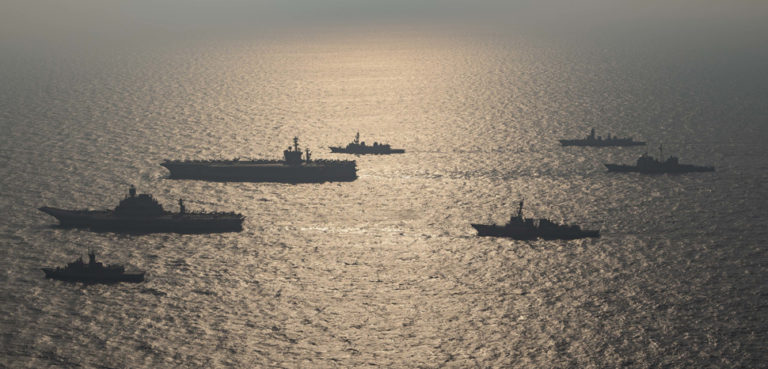With the rising challenge of China, Indo-Pacific geopolitics is headed for more uncertainty. In his recent visit to India, Australia Prime Minister Anthony Albanese visited INS Vikrant, India’s newest aircraft carrier.
Aboard the INS Vikrant, PM Albanese declared that “there has never been a point in both of our country’s histories where we’ve had such a strong strategic alignment.” He noted that India is a “top-tier security partner” and that the Indian Ocean is “central to both countries’ security and prosperity.”
The visit to INS Vikrant underscores the growing importance of the maritime dimension of Indo-Pacific geopolitics. Hosting the Australian PM on an aircraft carrier is also a demonstration of the strength of India’s strategic ties with Australia. Furthermore, it underlines the evolving strategic alignment between India and Australia.
The defence and security partnership has emerged as one of the key pillars of Indo-Australian strategic partnership. Both countries are participants in the Malabar naval exercises and are deepening and widening their military-to-military exchanges. Australia has invited India for Exercise Talisman Sabre. Such joint exercises not only build interoperability and familiarity but also contribute to creating greater trust and awareness about each other.
In the context of growing Chinese assertiveness across the Indo-Pacific, military cooperation has assumed critical dimensions. Just like India, Australia too faces growing Chinese challenge in its own region. China’s forays in the South Pacific have galvanised Australia and the United States into action. India too is slowly increasing its outreach to the island states of South Pacific.
The security in the Eastern Indian Ocean, especially along maritime Southeast Asia, is a shared area of concern for India and Australia. China looms large, geographically as well as strategically, over this region. Building strategic convergence to limit Chinese influence and expanding the strategic partnership is in the interest of India and Australia.
Along with defence and security, trade and economy are also key areas of cooperation. India and Australia signed an Economic Cooperation and Trade Agreement (ECTA) last year. The agreement is expected to add economic muscle to the burgeoning politico-military partnership. As India refused to join the Regional Comprehensive Economic Partnership (RCEP), bilateral trade deals with Indo-Pacific countries matter. India-Australia ECTA will build on the already strong education and people-to-people links.
Minilateral Co-operative Frameworks
Apart from the participation in the Quad and Malabar Exercises, India and Australia are working together with other Indo-Pacific countries on a range of issues. India is likely to be a key partner for the Five Eyes Intelligence Cooperation initiative. It includes five English-speaking countries: US, Britain, Canada, Australia, and New Zealand. Bringing India into this framework is a logical next step.
Moreover, there is a trilateral mechanism between India, Indonesia, and Australia. The three countries hold significant stakes in the security and stability of the Eastern Indian Ocean. They are also strengthening their bilateral strategic ties which will invariably contribute to the reinforcing of the trilateral framework. Although the India, France and Australia trilateral framework received a setback in the wake of AUKUS, it is now being revived.
In 2021, in the wake of COVID-19 pandemic, Australia and India, along with Japan, launched the Supply Chains Resilience Initiative. India and Australia believe in “diversified, transparent, open, secure, inclusive and predictable” global supply chains. The goal of SCRI has been to address vulnerabilities in global supply chains and to manage the risks emanating from supply chain disruptions.
Strengthening the Weakest Link
Amongst these minilateral frameworks, however, the Quad is the most important. The lack of strong India-Australia bilateral relationship was perhaps the weakest link in the Quad. All other countries enjoyed a close bilateral strategic relationship with each other. It didn’t help that Australia took the lead in 2007-8 to stymie the idea of Quad 1.0, in order to avoid offending China’s sensitivities.
However, now, the strategic context has changed, and India and Australia are willing to partner with each other in the Indo-Pacific. They are willing to take risks and demonstrate greater intent. Both countries see the Chinese challenge as a key factor that binds them together. They are less worried today, than in the past, about the Chinese response.
India and Australia share key binding factors like the history of British colonialism, commitment to democracy and human rights, English language, and the love of the game of cricket. However, so far, these values were not sufficient to evolve a strategic convergence. The changing geopolitics of the Indo-Pacific has managed to bridge this gulf and is bringing them closer. The foundation of shared values and clarity about geopolitics will ensure the strategic alignment between India and Australia.
The views expressed in this article belong to the authors alone and do not necessarily reflect those of Geopoliticalmonitor.com.
Sankalp Gurjar is an Assistant Professor at the Department of Geopolitics and International Relations, Manipal Academy of Higher Education, Udupi, India. He is the author of The Superpowers’ Playground: Djibouti and Geopolitics in the Indo-Pacific in the 21st Century.




